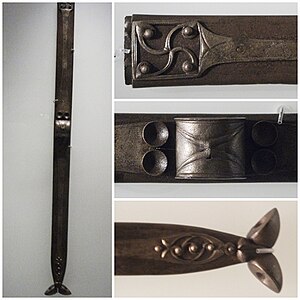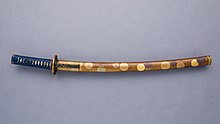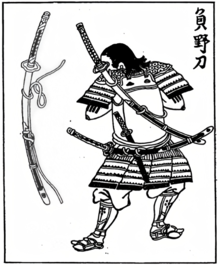
A baldric is a belt worn over one shoulder that is typically used to carry a weapon or other implement such as a bugle or drum. The word may also refer to any belt in general, but this usage is poetic or archaic. In modern contexts, military drum majors usually wear a baldric.

A Japanese sword is one of several types of traditionally made swords from Japan. Bronze swords were made as early as the Yayoi period, though most people generally refer to the curved blades made from the Heian period (794–1185) to the present day when speaking of "Japanese swords". There are many types of Japanese swords that differ by size, shape, field of application and method of manufacture. Some of the more commonly known types of Japanese swords are the uchigatana, tachi, ōdachi, wakizashi, and tantō.
A sword is an edged, bladed weapon intended for manual cutting or thrusting. Its blade, longer than a knife or dagger, is attached to a hilt and can be straight or curved. A thrusting sword tends to have a straighter blade with a pointed tip. A slashing sword is more likely to be curved and to have a sharpened cutting edge on one or both sides of the blade. Many swords are designed for both thrusting and slashing. The precise definition of a sword varies by historical epoch and geographic region.
A tachi is a type of sabre-like traditionally made Japanese sword (nihonto) worn by the samurai class of feudal Japan. Tachi and uchigatana generally differ in length, degree of curvature, and how they were worn when sheathed, the latter depending on the location of the mei (銘), or signature, on the tang. The tachi style of swords preceded the development of the katana, which was not mentioned by name until near the end of the twelfth century. Tachi were the mainstream Japanese swords of the Kotō period between 900 and 1596. Even after the Muromachi period (1336–1573), when katana became the mainstream, tachi were often worn by high-ranking samurai.
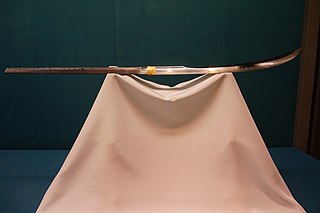
The naginata is a polearm and one of several varieties of traditionally made Japanese blades (nihontō). Naginata were originally used by the samurai class of feudal Japan, as well as by ashigaru and sōhei. The naginata is the iconic weapon of the onna-musha, a type of female warrior belonging to the Japanese nobility. A common misconception is that the Naginata is a type of sword, rather than a polearm.

A tantō is one of the traditionally made Japanese swords that were worn by the samurai class of feudal Japan. The tantō dates to the Heian period, when it was mainly used as a weapon but evolved in design over the years to become more ornate. Tantō were used in traditional martial arts. The term has seen a resurgence in the West since the 1980s as a point style of modern tactical knives, designed for piercing or stabbing.
A dirk is a long-bladed thrusting dagger. Historically, it gained its name from the Highland dirk where it was a personal weapon of officers engaged in naval hand-to-hand combat during the Age of Sail as well as the personal sidearm of Highlanders. It was also the traditional sidearm of the Highland Clansman and later used by the officers, pipers, and drummers of Scottish Highland regiments around 1725 to 1800 and by Japanese naval officers.
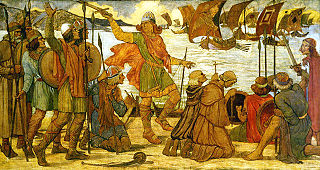
Knowledge about military technology of the Viking Age is based on relatively sparse archaeological finds, pictorial representations, and to some extent on the accounts in the Norse sagas and laws recorded in the 12th–14th century.
The pugio was a dagger used by Roman soldiers as a sidearm. It seems likely that the pugio was intended as an auxiliary weapon, but its exact purpose for the soldier remains unknown. Officials of the empire took to wearing ornate daggers in the performance of their offices, and some would wear concealed daggers for defense in contingencies. The dagger was a common weapon of assassination and suicide; for example, the conspirators who stabbed Julius Caesar used pugiones. The pugio developed from the daggers used by the Cantabrians of the Iberian peninsula.

Japanese sword mountings are the various housings and associated fittings that hold the blade of a Japanese sword when it is being worn or stored. Koshirae (拵え) refers to the ornate mountings of a Japanese sword used when the sword blade is being worn by its owner, whereas the shirasaya is a plain undecorated wooden mounting composed of a saya and tsuka that the sword blade is stored in when not being used.

Chape has had various meanings in English, but the predominant one is a protective fitting at the bottom of a scabbard or sheath for a sword or dagger. Historic blade weapons often had leather scabbards with metal fittings at either end, sometimes decorated. These are generally either in some sort of U shape, protecting the edges only, or a pocket shape covering the sides of the scabbard as well. The reinforced end of a single-piece metal scabbard can also be called the chape.

A shotel is a curved sword originating in Eritrea and northern Ethiopia. The curve on the blade varies from the Persian shamshir, adopting an almost semicircular shape. The blade is flat and double-edged with a diamond cross-section. The blade is about 40 inches (1,000 mm) in total length and the hilt is a simple wooden or rhinoceros horn piece with no guard similar to the jile or jambiya. The shotel was carried in a close fitting leather scabbard which was often decorated in precious metals and worn on the right side.

Japanese swordsmithing is the labour-intensive bladesmithing process developed in Japan beginning in the sixth century for forging traditionally made bladed weapons (nihonto) including katana, wakizashi, tantō, yari, naginata, nagamaki, tachi, nodachi, ōdachi, kodachi, and ya (arrow).

The Model 1840 noncommissioned officers' sword was adopted by the United States military in 1840. Based primarily on a sword used by the French Army, the model 1840 NCO proved somewhat heavy hilted and ill balanced. For over 70 years, it was widely used by the Army; today its usage is restricted to ceremonial occasions. The sword had a 31-inch blade, a cast brass hilt resembling the more expensive wire-wrapped leather grips, and a leather scabbard rather than the steel used by cavalry troopers and officers, although some makers, such as Emerson and Silver, issued a steel scabbard rather than leather to protect from wear. Leather scabbards were phased out beginning in 1868.

The Pattern 1796 heavy cavalry sword was the sword used by the British heavy cavalry, and King's German Legion Dragoons, through most of the period of the Revolutionary and Napoleonic Wars. It played an especially notable role, in the hands of British cavalrymen, at the battles of Salamanca and Waterloo. The pattern was adopted by Sweden and was used by some Portuguese cavalry.

The guntō was a ceremonial sword produced for the Imperial Japanese army and navy after the introduction of conscription in 1872.

Scholars agree that Japanese armour first appeared in the 4th century, with the discovery of the cuirass and basic helmets in graves. During the Heian period (794-1185), the unique Japanese samurai armour ō-yoroi and dō-maru appeared. The Japanese cuirass evolved into the more familiar style of body armour worn by the samurai known as the dou or dō, with the use of leather straps (nerigawa), and lacquer for weatherproofing. Leather and/or iron scales were also used to construct samurai armours, with leather and eventually silk lace used to connect the individual scales (kozane) of these cuirasses.
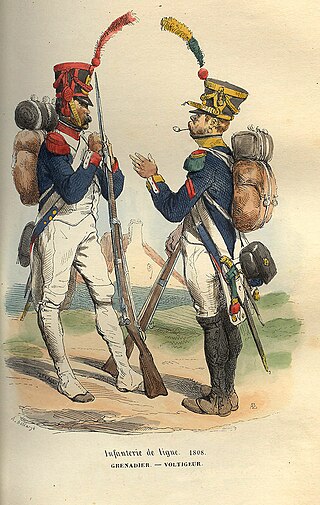
In military uniforms, a shoulder belt is a wide belt worn usually over the shoulder and across the body. With nearly all line infantry, skirmishers, light infantry, grenadiers and guard regiments, two shoulder belts were worn - one carrying the cartridge box, and another for the bayonet, a sword, or other military equipment.

Many different weapons were created and used in Anglo-Saxon England between the fifth and eleventh centuries. Spears, used for piercing and throwing, were the most common weapon. Other commonplace weapons included the sword, axe, and knife—however, bows and arrows, as well as slings, were not frequently used by the Anglo-Saxons. For defensive purposes, the shield was the most common item used by warriors, although sometimes mail and helmets were used.

A rain-guard or chappe is a piece of leather fitted to the crossguard of European swords of the later medieval period. The purpose of this leather is not entirely clear, but it seems to have originated as a part of the scabbard, functioning as a lid when the sword was in the scabbard.
